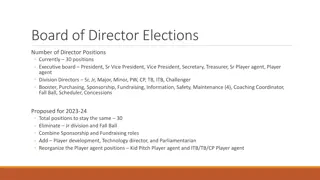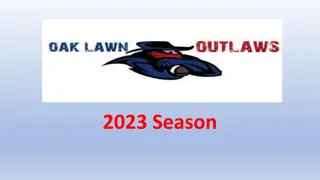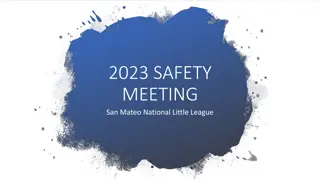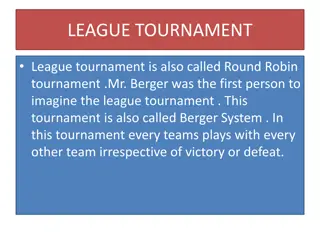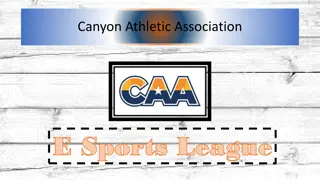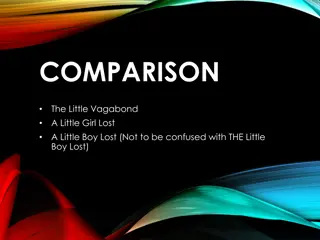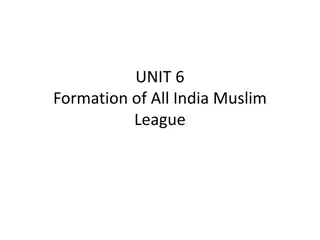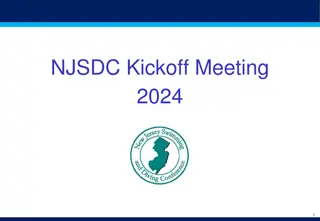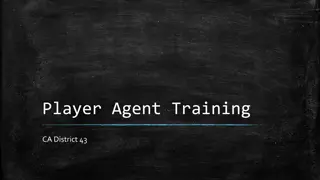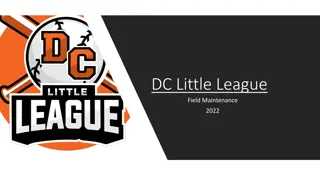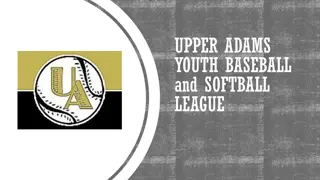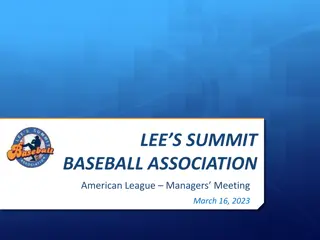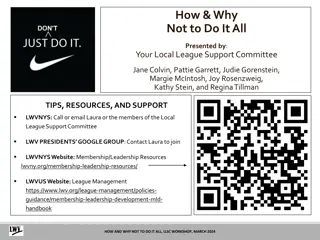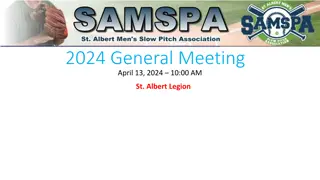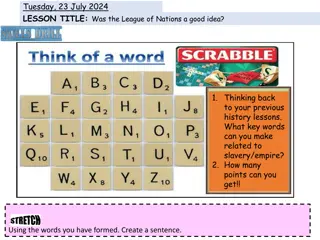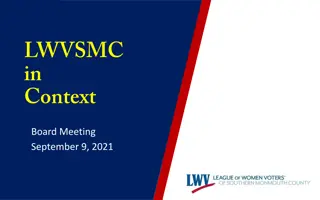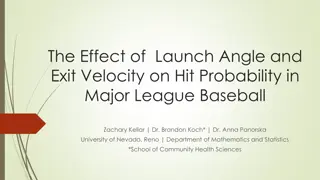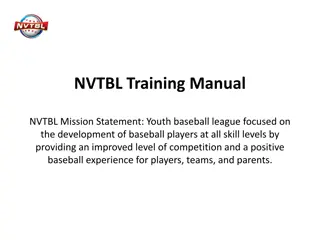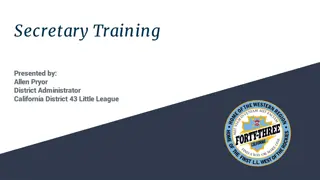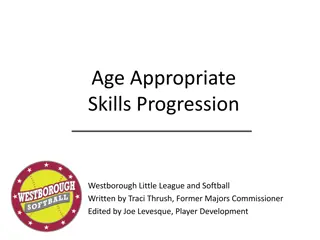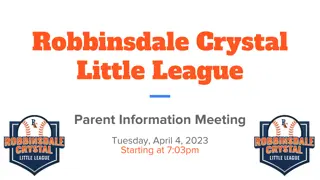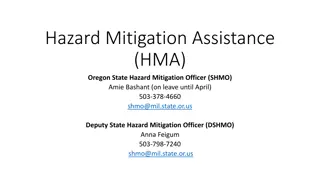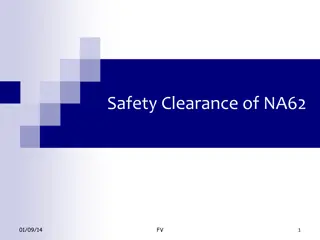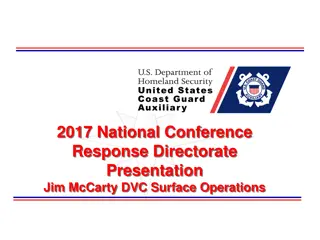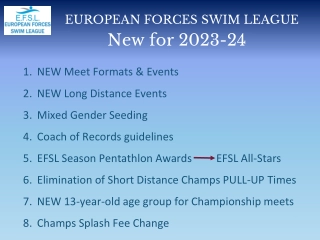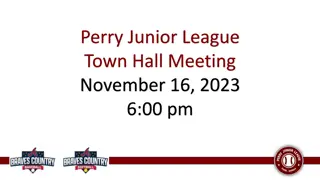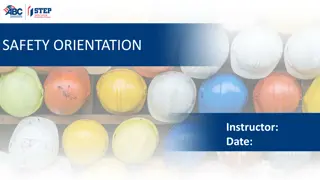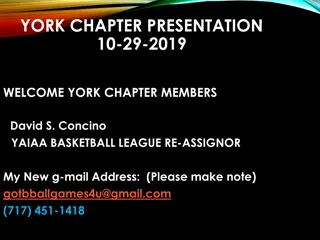Clackamas Little League Safety Guidelines Presentation
Clackamas Little League emphasizes safety measures for participants and spectators amid the COVID-19 pandemic. Guidelines include wearing masks, social distancing, sanitizing, health screenings, and reporting exposure to COVID-19. Practices, games, and event attendance are all regulated to minimize risks, with a focus on cleanliness and preventive measures.
Download Presentation

Please find below an Image/Link to download the presentation.
The content on the website is provided AS IS for your information and personal use only. It may not be sold, licensed, or shared on other websites without obtaining consent from the author. Download presentation by click this link. If you encounter any issues during the download, it is possible that the publisher has removed the file from their server.
E N D
Presentation Transcript
Clackamas Little League Safety Awareness Presentation
Covid-19 Safety & Guidelines
General Guidelines for Participants & Spectators Clackams Little League (CLL) strongly encourages those at higher risk for severe COVID-19 complications and their family members to continue to stay home to reduce their risk of exposure. CLL will follow all pertinent guidance from the Oregon Health Authority (OHA) and the Oregon Schools Activities Association (OSAA). Teams will keep participant logs for practices and games. Teams will name at least one parent safety coordinator per event to assist or oversee sanitizing, social distancing, participant logs, and other safety measures. The umpires will have the authority to stop games if proper mask wearing, physical distancing, or equipment use standards are not maintained. Families must do their part (for instance: staying away when sick, reporting COVID-19 related exposure to the coaching staff and league, following allowable group size to attend ballgames, etc.).
Guidelines for Practices & Games Teams will follow Multnomah County guidelines for outdoor group gatherings (number of attendees etc). All players, coaches, umpires and spectators must wear a mask properly at all times. Umpires must stand either in the infield at least 6 from the nearest player, or must maintain a 6 distance from the catcher and batter if they choose to remain behind the plate. Coaches and parent safety coordinators will advise and encourage frequent hand sanitizing. Players should social distance (6 feet or more) whenever they are not actively engaged in the game. No drinking from water fountains. No shared water bottles or snacks, no seeds and no spitting. If eating is necessary, a 6 feet social distance must be maintained and hands must be sanitized before and after eating. Water bottles should be clearly marked with the participant's name. No postgame huddles or handshakes. Spectators should maintain social distancing at all times.
Guidelines About Attending Events Players, coaches and spectators will complete a pre-practice/game screening at home before every event. Anyone with a fever (100.4 degrees or higher) or other symptoms suggestive of Covid-19 is prohibited from the field for a minimum of 72 hours following resolution of fever and a minimum of 10 days from onset of symptoms. Any player or coach exposed (indoors and without a mask) to someone with COVID-19 must stay home for a period of 10 days. If a player or coach develops one or more symptoms of COVID-19 during the practice/game, they will be isolated away from others immediately, and sent home as soon as possible. Minors will be supervised until they are picked up by a parent. Any COVID-19 related exposure, symptoms, or diagnosis must be immediately reported to the coaching staff and/or a league official. If any player or coach contracts COVID-19, his or her team will shut down for a period of time, following OHA guidelines.
Guidelines Regarding Equipment Parents are responsible for cleaning and sanitizing the player s equipment after each game. Teams will be provided 2 sets of catcher s gear, and are encouraged to play only 2 players at the catcher position each practice/game to reduce the spread of germs. Team equipment (balls and tees) will be designated for each team. If equipment must be shared between groups it will be sanitized before and after use by each team. The team on defense will provide the game balls for each half-inning. The defensive coaches are responsible for changing out game balls. Teams will sanitize shared equipment (like balls) after each practice/game. The parent safety coordinator will ensure the safe and correct application of disinfectants and keep these products away from children.
Equipment Handling/Cleaning for Coaches Minimize equipment sharing, and clean and disinfect shared equipment between use by different people to reduce the risk of COVID-19 spread. Make frequent use of sanitary wipes and hand sanitizer that are provided by the league. These supplies will be stocked in the equipment sheds and each equipment bag will have hand sanitizer. A designated coach should retrieve bats that are discarded by players at home plate. That coach should wash hands or apply hand sanitizer regularly. Clean and disinfect shared objects and equipment at the end of the game or practice.
First Aid P.R.I.C.E.S. P: Prevention, Preparation, and Protection R: Rest I: Ice C: Compression E: Elevate S: Support
Prevention, Preparation, Protection PREVENTION: Encourage all players to have a pre-participation sports physical. Most physicians or clinics will make sure that the players are up to date on their vaccines (tetanus, pertussis, meningoceccemia, etc.) PREPARATION: prepare by knowing what is in your first aid kit, as well as when and how to use an item. Make sure you have easy access to players medical release forms. PROTECTION: includes not only the individual player but also their teammates, coaches, etc. Keep in mind that at all times the field is in your domain. Take ownership of the potential for injury or illness that others (including parents) may not recognize.
Rest - Ice - Compression - Elevate Rest: Rest is just as important in preventing an injury as it is in rehabbing one. Ice: Ice is important in reducing inflammation resulting from strains and sprains, but is completely ineffective in the presence of fractures. Be sure to use ice appropriately Compression: Compression is an important aspect of strain and sprain rehab. It can help to keep swelling down, which increases blood flow to the affected area. Elevate: Elevate to keep pressure and swelling of the affected joint down and increase blood flow.
Support Support: The prevention of injuries is our primary goal and, as the "experts", we are required to share with the players and their parents our knowledge, wisdom, and diligence to attain that goal. Players may not know that they should or may be afraid to tell you when they are experiencing pain, so it is vitally important that we express to them the need for them to do just that. And should a player experience an injury, it is our requirement as the "experts" that we ensure that a player's injury is sufficiently healed prior to allowing them to resume play.
Typical Injuries Insect Stings and Bites (allergy alert!) Contusions (bruises and abrasions) Sprains (ligaments - bone to bone) and strains (tendons - muscle to bone) Injuries to Small Joints Fractures Facial Injuries Blunt Force Chest Trauma Heat Illness Concussions
Heat Related Illness There are 3 types of heat illness: 1: Heat cramps Cramping is often the result of dehydration and electrolyte imbalance. Cramps may occur during or after exercise. The body temperature remains normal. Treatment involves stopping the exercise, massaging and stretching the involved muscle, and rehydrating by drinking water or an appropriate carbohydrate-electrolyte drink.
2: Heat exhaustion Heat exhaustion occurs in athletes who sweat profusely and experience mild to moderate volume depletion. Core body temperature ranges 100.4- 104. Symptoms include nausea, vomiting, headache, dizziness, fainting, confusion, and inattention. For treatment, stop the exercise and immediately move the athlete to a cool, shaded area. On-site cooling with fans, ice bags, etc should be initiated. Unnecessary equipment should be removed. If the athlete is cooperative and alert enough, begin rehydration by having him/her drink water or an appropriate carbohydrate-electrolyte drink. 3: Heat stroke This is a life-threatening medical emergency with a mortality of 10% when good medical management occurs. Heatstroke is defined as a core temperature of greater than 104 and is accompanied by hot, dry skin (they stopped sweating) and central nervous system abnormalities (confusion, seizures, or coma). If the youth has collapsed or is unconscious, call 911 immediately and follow the guidelines above. Move the athlete to a cool, shaded area. On-site cooling with fans, ice bags, etc should be initiated. Unnecessary equipment should be removed.
Severe Allergic Reaction / Anaphylaxis Signs and Symptoms: Sudden weakness all over Child looks pale and/or is confused Sudden headache Breathing difficulties (wheezing or shortness of breath) Sudden stomach cramps or vomiting Pulse is rapid or weak Loss of consciousness or collapse If any of these signs are present, act immediately: Stay with the child and direct an adult to call 911. Follow instructions of the special insect bite kit or epipen. Begin CPR if needed. Send 2 adults to the nearest intersection to direct emergency personnel to the correct field/location. Contact parents and inform them of the situation. If parents are not present, stay with the child and ride to the ER with them. Make sure to have the child's medical release form with you. Stay with the child until parents or guardians arrive.
Summary Do no harm Always trust your instincts P.R.I.C.E.S.
Concussions A concussion is a transient, traumatic disruption of neural function.The signs and symptoms reported in athletes who have experienced a concussion are varied. Even a minor concussion can result in symptoms that last for several days. Loss of consciousness and amnesia are symptoms that have formed the basis for most concussion grading scales. Most athletes who experience a concussion do not lose consciousness. If the athlete is unconscious, the neck must be immobilized to prevent catastrophic damage to the cervical spine. Next, the airway must be established and adequate ventilation ensured. DO NOT MOVE THE ATHLETE FROM THE FIELD UNTIL CLEARED BY MEDICAL PERSONNEL. If the athlete regains consciousness on the field, stand firm in your stance to not allow him/her to be moved. Stay with the athlete.
Signs & Symptoms of a Concussion Headache Dizziness Confusion Nausea Unsteadiness Concentration difficulties Disorientation Amnesia Loss of consciousness Irritability Vomiting Visual disturbance Ringing in the ears Performance impairment Sleep disturbance Seizure
If a medical professional, Umpire in Chief, the players coach, the players manager, or the players parent has determined a player sustained a possible concussion, the player must, at a minimum, be removed from the game and/or practice for the remainder of that day. The league must be aware of its respective state laws with regards to concussions and impose any additional requirements as necessary. The player s return to full participation is subject to: 1) the league s adherence to its respective state laws, 2) an evaluation and a written clearance from a physician or other accredited medical provider, and 3) written acknowledgement of the parents. As people have become more aware of the potentially devastating effects of concussions, most states in America have implemented concussion laws regarding young athletes and when they can safely return to sports and academic activity. In 2009, Washington became the first state to enact a concussion law; Oregon followed suit in 2010. Most laws require education or annual training for coaches or staff. They also require that any athlete suspected of sustaining a concussion must be removed from play or practice and must be cleared by a medical professional before returning to activity.
Oregon State Laws Regarding Concussions Max's Law (2009 OR Senate Bill 348) This Oregon law applies to school-related sports. It is named after Max Conradt, a high school quarterback who sustained a concussion in a football game. Without receiving medical clearance, he played in the next game. Max collapsed at halftime due to massive bleeding in his brain, even though no remarkable hits were observed. He required multiple brain surgeries, and was in a coma for three months and now lives in a group home for adults with brain injuries. Jenna's Law (2013 OR Senate Bill 721) Jenna's Law was signed enacted in 2013, and became effective January 1, 2014. It is named after Jenna Sneva, a young woman who sustained at least 11 concussions while participating in club soccer and competitive skiing. She suffered physical and cognitive deficits (difficulty thinking) from repeated brain injuries. Jenna's Law essentially extends Max's Law to nonschool-affiliated sports for youth athletes.
Common Safety Issues
Fitness of the Field Before the game starts, the managers of both teams must agree on the fitness of the playing field. After the game starts, the umpire-in-chief is the sole judge as to whether and when play is suspended during a game because of unsuitable weather conditions or the unfit condition of the playing field. The umpire-in-chief also determines whether to resume or terminate play after a suspension.
Persons Allowed on the Field Only uniformed players, managers, coaches and umpires are allowed on the playing field. Batboys and batgirls are not allowed on the field or in the dugout.
Prohibited Items Players must not wear jewelry such as rings, watches, earrings, bracelets, necklaces, or any hard cosmetic decorative items. The material making up the decorative item is irrelevant. Exception: Players may wear medical alert jewelry. Players must not play with a cast. They must remain in the dugout. In the Major Division and below, players may not wear metal spikes.
Glasses and Sunglasses Glasses are allowed. Sunglasses are allowed. No prescription required. Players can wear sunglasses on top of their hat.
Catchers All catchers in all divisions must wear: Catcher s mitt and shin guards Traditional helmet and mask or a hockey style helmet Dangling throat protector Short-model or long-model chest protector. Male catchers must wear a protective cup. Catchers must wear a catcher s helmet with dangling throat guard during games, pitcher warm-up, and any form of infield or infield/outfield practice.
Batting Helmets In all cases, whether in a game or a practice, the following players must wear a batting helmet that covers both ears: Batters: any player holding a bat at any time Base Runners: any player depicted as a base runner at any time Base Coaches: any player depicted as a base coach at any time Adult Base Coaches and defensive players: helmet is optional
Batting Helmets Face masks or face shields are allowed but not required. Helmets MUST be NOCSAE-approved (noted on helmet). Helmets must NOT include any words, letters, logos, stickers, paint etc., unless applied or approved by the manufacturer. Highly polished, chrome colored batting helmets are not allowed.
On Deck Batters: Major & Below In the Major Division and below: The on-deck position is not permitted. Fenced-in areas may not be used for an on-deck better. Only the first batter of each half-inning is allowed outside the dugout between half-innings. The next batter should be ready with a helmet on, but may not pick up a bat until it is his/her turn to bat.
On Deck Batters: 50/70 In the Intermediate Division (50/70) Division: The on-deck position is permitted. Right-handed batter, on-deck position is near third base. Left-handed batter, on-deck position is near first base. The traditional batting donut is not permitted.
Coaches May Not Warm Up Pitchers Managers and coaches must not warm up a pitcher: at home plate in the bullpen or elsewhere at any time They may stand by to observe a pitcher.
Players Warming Up Pitchers Catchers must wear a catcher s helmet with dangling throat guard during games, pitcher warm-up, and any form of infield or infield/outfield practice. Cup and other catcher s equipment not required. May squat.
Base Coaches Two base coaches required Eligible player in uniform and/or team manager or coaches One adult manager or coach must remain in the dugout. Coaches must not leave dugouts until pitcher has completed warm-up pitches.
Throwing the Bat - Intentional There is no rule that covers thrown bats. Umpires do not have authority to call a batter out for throwing a bat. If intentional, an umpire may eject a player for unsportsmanlike conduct. This is harsh penalty because ejection disqualifies player from the next game.
Throwing the Bat - Unintentional When a player throws a bat or engages in other potentially unsafe actions, the umpire should: Warn the player and members of the player's team. Recommend to the player s manager to substitute for the offender until the player is properly trained. Ultimately the team manager is responsible for teaching the players the proper way to discard a bat.
There is No Must Slide Rule The runner is out when: the runner does not slide or attempt to get around a fielder who has the ball and is waiting to make a tag A runner has two other options: give up retreat
Sliding Head First In the Major Division and below, any runner is out when the runner slides head first while advancing. A runner may dive head first when returning to a base. Falling head first is not necessarily the same as sliding. Use your judgment.
Breakaway Bases First, second, and third bases must dislodge from their anchor. Breakaway bases must be used at every practice and game.
Baseball Pitch Limits League Age Pitches Per Day 7-8 50 9-10 75 11-12 85 13-16 95
Baseball Rest Periods Pitches Days Rest 0-20 0 21-35 1 36-50 2 51-65 3 66 or more 4 A pitcher may not pitch in 3 consecutive days.
Pitch Limit and Rest Period Exceptions If a pitcher reaches a limit while facing a batter, the pitcher may continue to pitch until anyone of the following occurs: That batter reaches base That batter is put out The third out is made to complete the half inning or game.
Catcher/Pitcher Limits Pitcher to Catcher: Any pitcher who delivers 41 or more pitches in a game Not eligible to catch for remainder of the day Rule allowing pitcher to complete pitching to batter does not apply. Catcher to Pitcher: Any player who has played catcher for more than three innings in a game (three innings plus a pitch) Not eligible to pitch on that calendar day
Removed Pitcher - Baseball Removed Pitcher (Major Division and below): Pitcher removed cannot return as a pitcher Removed Pitcher (50/70 Division and above): Pitcher removed can return as pitcher anytime in the game Pitcher must remain in the game in a different position Pitcher may return only once per game
Multiple Games - Baseball Players may not pitch in more than one game in a day. Softball: No such rule.
Softball Pitch Limits and Rest Minor and Major Divisions: Maximum of 12 innings per day 1 day rest required if pitch in 7 innings or more Delivery of 1 pitch constitutes having pitched in an inning Junior Division and above: No pitching restrictions
Removed Pitcher - Softball Minor and Major Divisions: A pitcher remaining in the game, but moving to a different position, can return as a pitcher anytime in the remainder of the game but only once in the same inning as she was removed. A pitcher withdrawn from the game offensively or defensively for a substitute, may not re-enter the game as a pitcher.
Accident Reporting Procedures
How to Make the Report Complete Little League s Incident/Injury Tracking Report found in the team safety kits & on our website under the Safety and Insurance tab.
What to report: Any incident that causes any player, manager, coach, umpire, volunteer or spectator to receive first aid and/or seek medical treatment. Who to report to: Contact CLL s Safety Officer by email or by phone. When to report: Managers/coaches must report injuries to CLL s Safety Officer within 48 hours of the incident. If the injury is serious (or potentially serious) in nature, notify the Safety Officer via phone as soon as possible.


